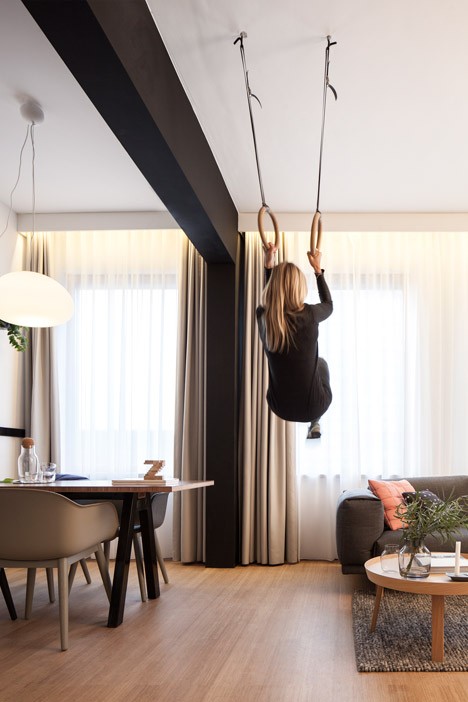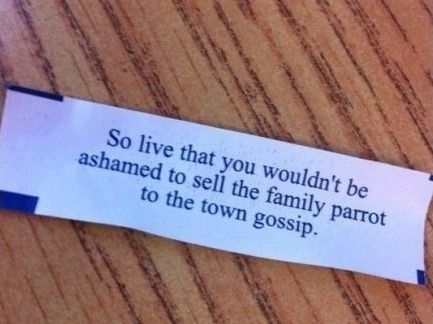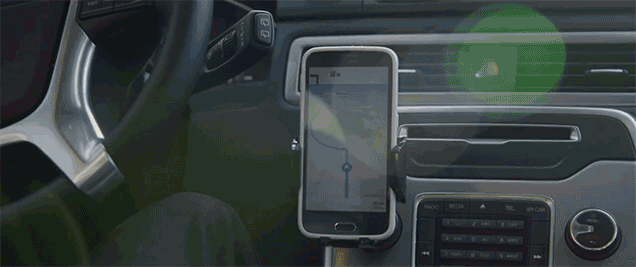
The Collar Stay Punch lets you turn old credit cards, gift cards, and other pieces of plastic into collar stays.
(Want more? See NOTCOT.org and NOTCOT.com)

Sit in the driver’s seat as the QX30 concept car is created around you
For the second of two innovative films that debuted at this year’s Pebble Beach Concours d’Elegance, Infiniti’s Executive Design Director, Alfonso Albaisa, takes viewers into the design process of the QX30 concept car. “From Pencil to Metal” brings you into the studio to see initial sketches of the vehicle being scribbled in thin air, as the car is created around you. From CAD files to clay modeling to the impeccable finished product, the team at Infiniti has put the driver first, creating a virtual reality experience where the car takes shape around you-literally; thanks to YouTube’s 360 degree video playback, users can look around the car as it comes to life. The team behind the project tells us, “Traditional media can be one-sided, and seem to talk at consumers. But VR allows us to literally bring them inside of the Infiniti brand, an Infiniti car and an engaging story.”
This post is sponsored by Infiniti.

Maximizing usable space in a series of compact short-term apartments, these retractable steps slip back into a wall, all but disappearing beneath lofted bedroom areas when not needed. Drawers and other storage slots are designed around the dimensions of the zigzag shape created by the profile of the stairs while the railing above sits flush with the bedroom space divider.


Driving these space-saving retrofits is a desire to make hotel rooms feel more like homes, particularly since many guests of Zoku in Amsterdam end up staying for longer than a typical traveler would.


Each of the 133 units (270 square feet each) redesigned by Concrete features a similar set of unconventional amenities: a secret desk tucked beneath the bed, a slatted wood divider providing both privacy and light to the bedroom area above, hidden stairs that slide into the wall for access and a pair of suspended gymnast hoops hanging from the ceiling.


A combination of black and white, wood and bamboo, ceramic and organic elements help the spaces feel more variegated, like a house populated with individual furnishings and objects over time rather than a place made by a corporate hotel.


From the owners and architects: “A room at Zoku is much more than just a hotel room. It is a spacious micro-apartment. As space is becoming scarcer in urban areas, the way we use it sustainably to meet long-term accommodation requirements is more and more relevant. Smart solutions that create the opportunity to use less square metres and facilitate 24/7 multifunctional use are needed.”








Don't let your child out of the house without this stylish pink bullet-proof backpack. It has been "tested against 2 types of ammunition, yet weighs just a few more ounces than non-armed backpacks. Ideal for everyone, including students, law enforcement and military personnel and security staff."

While you're at it, why not grab a 3-pack of P.S. Products Strike Spikes: "Just attach the thick, quarter-sized aluminum disc to the back of your baseball-style cap. Whip your cap off and fight back with the Strike Spike's short but ultra-sharp spikes. Or wear it on your watch band so you can strike an assailant before he even gets a chance."
(Thanks, Andreas!)
When I first read a description of misophonia, my reaction was: Other people have this?! This intense, angry reaction to everyday sounds like chewing, lip-smacking, sniffing, and pen-clicking—sounds that other people can ignore?
My second reaction was: Damn. I just diagnosed myself off the Internet.
And my third reaction was: Wait. I’m a science writer and a scientist. So I’ll do the (moderately) rational thing: corner some scientists who study misophonia and ask them some questions. Like, what do we know about misophonia? Can we treat it? And should we actually be calling it a disorder, on par with major depression and bipolar disorders?
I started at PubMed, the massive database of peer-reviewed scientific articles maintained by the National Library of Medicine. But compared to the hundred thousand hits I got for searching on major depression disorder, a search for misophonia pulled up only 26 articles. Most were published in the past few years.
One of the few labs that have published on the subject is run by author, TED talker, and neuroscientist Vilayanur Ramachandran. When people from an Internet support group for misophonia first contacted the lab, “we were kind of skeptical,” says doctoral student Miren Edelstein of the University of California, San Diego. “Nobody had heard of this disorder” back in 2011, and people often asked to have their unusual ailments studied by Ramachandran.
But when Edelstein and her colleagues interviewed 11 volunteers from the support group, they were struck by the common patterns. Each volunteer reacted intensely to what Edelstein describes as “chewing, mouthy sounds” made by adults. When she exposed people with and without misophonia to trigger sounds like loud chewing, sniffing, and lip-smacking (urgh), both sets of people reacted negatively. The people with misophonia just reacted more—indicating, perhaps, that misophonia might just be at the extreme end of a normal distribution. Perhaps the people with misophonia had unusually strong neural connections between sound-processing parts of their brains and their limbic systems, which help regulate emotion.
The volunteers knew their aggressive reactions were inappropriate and outsized. They told Edelstein how they’d developed coping mechanisms, such as leaving the room, avoiding certain situations, using headphones, and even mimicking their trigger sounds to mask the noise. Some of these coping mechanisms negatively affected their work and home lives.
The strong distaste for “chewing, mouthy sounds” and coping mechanisms sounded eerily familiar to me, although my coping strategies weren’t seriously affecting me. But this study only looked at 11 self-selected volunteers. What about misophonia among the rest of us?
One team has examined how common misophonia is in a general population. In 2014, clinical psychology doctoral student Monica Wu, psychologist Eric Storch, and their colleagues at the University of South Florida surveyed 483 undergraduate students about misophonia symptoms.* That’s not to say that these 483 students perfectly represented the world: Almost 60 percent were white, more than 80 percent were women, and 100 percent were participating in the study to get extra credit for their psych classes.
Wu and her colleagues found that a full 20 percent of the students reported what the researchers considered clinically significant misophonia symptoms. The Florida students with significant symptoms had “this extreme reaction to really selective sound stimuli,” says Wu—stimuli like the mouthy noises described in Edelstein’s study. They also used similar coping mechanisms. Sadly, half of those with clinical symptoms—about 10 percent of all the students—reported that they had significant trouble functioning at school and work. That high of a number surprised me at first, but then again, I can totally understand why people don’t talk about what feels like a crazy, aggressive overreaction to lip-smacking (urgh).
Intriguingly, Wu also found that misophonia symptoms tracked with symptoms of the psychiatric conditions anxiety, depression, and obsessive-compulsive disorder. I could understand people feeling anxious and depressed because of misophonia. But I was surprised by the connection to OCD, an anxiety disorder involving intrusive thoughts and the overwhelming need to soothe them with coping behaviors. However, Wu’s study wasn’t the first to suggest a connection between mental illness and misophonia.
In 2013, psychiatrist Arjan Schröder and his colleagues at the University of Amsterdam proposed that misophonia should be classified as a new psychiatric disorder. They suggested categorizing it on the spectrum with OCD. They had examined 42 patients who self-referred with misophonia, and found a consistent syndrome: Specific sounds triggered an aggressive response and socially isolating coping mechanisms. Schröder told me that almost half of these patients also met the criteria for obsessive-compulsive personality disorder.
So if misophonia is a psychiatric disorder, I wondered, could it be treated with medication or therapy?
Not necessarily. Wu has reservations about prescribing medication before we know more. But when it comes to therapy, she has some qualified hope. Her team reported successfully treating two young patients using cognitive behavioral therapy—a well-established form of psychotherapy that helps patients recognize distressing thoughts and develop healthier behaviors in response to those thoughts.
However, not all misophonia researchers agree that misophonia should be regarded as a psychiatric condition.
It’s an “extreme, inaccurate, and improper approach” to treat misophonia as a psychiatric disorder like OCD, says Emory University otolaryngology professor Pawel Jastreboff. He and his collaborator and spouse, Margaret Jastreboff, coined the term misophonia in 2001. They argue that misophonia is a form of decreased sound tolerance. He says they have seen hundreds of misophonia patients and that very, very few had any sort of psychiatric condition. Indeed, Jastreboff believes that the Dutch psychiatrists incorrectly linked misophonia to OCD because, he says, they were studying “psychiatric patients to start with, and some of them have misophonia.”
The Jastreboffs propose that misophonia is actually a learned response. They suggest that people with misophonia have learned to associate a negative reaction to something they originally considered just annoying—such as the culturally inappropriate sounds of bad table manners. Based on this idea, the Jastreboffs have been treating patients with a form of desensitization therapy. In this therapy, the person with misophonia is gradually retrained to associate positive experiences with formerly negative triggers—for example, by smelling and eating delicious cookies while in the presence of a noisy eater.
“Misophonia definitely can be treated successfully,” says Pawel Jastreboff, “but it is important to know how to do it.” In 2014, the Jastreboffs reported that 152 out of 184 misophonia patients—83 percent—had significant improvement after going through the desensitization therapy.
I still had reservations after I read their paper. Their study was observational, instead of the gold standard: the randomized control trial. All of the Jastreboffs’ patients were treated with the same therapy, so we can’t compare their improvement with what might happen naturally over time in untreated people or what would happen in people treated with other therapies. Plus, the study seemed ripe for a placebo effect because the scientists were asking people to self-report how they’re doing when they knew they’d just gone through months of desensitization therapy.
Not to say that Pawel Jastreboff is unaware of these limitations. “It would be a good idea” to evaluate therapies through controlled trials, he says, adding that “somebody hopefully will do that in the future.” For now, the Jastreboffs are both stymied by the “ten million dollars” he says it would take.
To be honest, this debate about the treatments and nature of misophonia didn’t surprise me. It’s a pretty new disorder, and not much research has been done on it. When there’s still so much uncertainty in the tiny community of misophonia researchers, is it actually helpful to refer to misophonia as its own separate disorder?
The scientists studying misophonia believe so, because of the terrible effects they see in their patients. The University of Amsterdam’s Schröder says that his patients “experience severe symptoms and frequently cannot function anymore.” They can’t eat dinner with their families, work effectively in big offices, or live happily with their spouses. Wu also sees significant impairment among kids with misophonia. In a previous case she worked on, the young patient couldn’t go to school and couldn’t even talk with the child’s mother, who made trigger sounds. And Edelstein reported that at least one of the 11 volunteers she interviewed had contemplated suicide.
In his 2013 study, Schröder and his colleagues wrote that they were proposing diagnostic criteria and psychiatric classification to “improve recognition by health carers and encourage scientific research” into misophonia. Getting misophonia recognized in the next edition of the Diagnostic and Statistical Manual of Mental Disorders, as some researchers are advocating, would certainly help in other ways, including the practical. “It helps with insurance,” says Wu. Furthermore, naming and identifying a disabling behavior as misophonia, she says, “does help in terms of giving it a face” and legitimacy to skeptical family and friends.
So what’s an Internet-self-diagnosed misophonic with a healthy dose of skepticism supposed to do?
Personally, as someone who doesn’t have much impairment beyond the occasional spike of extreme irritation, I plan to wait out the years of scientific discussion and debate. But after hearing about patients who are isolated, depressed, and even contemplating suicide, I definitely want to say this: There is help out there for people who are suffering and need someone to talk with.
And I hope that knowing about misophonia helps others who didn’t know there are other people who really can’t stand chewing, sniffing, and lip-smacking (urgh).
*Correction, Aug. 19, 2015: This article originally misidentified Eric Storch as a pediatrician. He is a psychologist who works in a pediatrics department.

I first encountered these tools on a site that dealt with Japanese imports. Apparently they’re more popular there than in North America.
They’re basically little handheld devices that punch through small stacks of paper and then fold tabs and slots together to secure the sheets to each other. That makes them serve as paperless staplers.
As long as you don’t have too many sheets, I’ve found that they work perfectly well. There are no consumables to replace, and the resulting stack doesn’t have any extra materials that could interfere with (or create extra work for) recycling.
We have a cheap plastic unit that we bought years ago from a site that I believe no longer exists, and it’s served without trouble.
-- Doug DeJulio
Kokuyo Harinacs Japanese Stapleless Stapler Black
$12
Available from Amazon
Manufactured by Kokuyo

If you dig these videos of DIY rubber band guns, which appear to be geekily faithful replicas of classic weapons, you should definitely be following parabellum1262 on YouTube.

[GIFs via IMGUR user progunil .]

A pair of typhoons are continuing to intensify far from land in the Northwest Pacific Basin as satellites and astronauts track their movements.
Typhoon Goni is projected to be in the vicinity of Taiwan and the Philippines by the end of this week, with Typhoon Atsani moving north toward Japan and possibly reaching super typhoon status — with sustained winds of 150 mph, or 130 knots — by Wednesday
At the moment, the latest projections from the Joint Typhoon Warning Center show Typhoon Goni coming close to Taiwan to the east on Sunday. Read more...
More about Us World, Us, Climate, Super Typhoon, and Typhoons
Going Hand In Hand, 8.5″ x 26″ x 15.5″, 2015, (Ceramic, acrylic)
Ceramicist Christopher David White (previously) accurately captures the decay of wood through ceramics, portraying the distinct character of the natural material from the fine wood grain to the light ash coloration at the pieces’ edges. By utilizing a trompe l’oeil technique, White forces the viewer to take a closer look at his work while also investigating the truth hidden in the hyperrealistic sculptures.
Through his ceramic pieces White explores the reality of impermanence, often combining man and nature through treelike limbs and faces. “I seek to expose the beauty that often results from decay while, at the same time, making my viewer question their own perception of the world around them,” explains White. He hopes to highlight the fact that we are not separate from nature, but rather intrinsically connected to it.
White has a BFA in Ceramics from Indiana University and MFA in Craft and Material Studies from Virginia Commonwealth University. White’s work will be included in the exhibition Hyper-realism at the Daejeon Museum of Art in South Korea opening this fall. (via Artist a Day)

Going Hand In Hand, 8.5″ x 26″ x 15.5″, 2015, (Ceramic, acrylic)

Going Hand In Hand, 8.5″ x 26″ x 15.5″, 2015, (Ceramic, acrylic)

A Walk That Is Measured And Slow, 14″ x 14″ 29″, 2015, (Ceramic, acrylic, drywall, iron oxide)

A Walk That Is Measured And Slow, 14″ x 14″ 29″, 2015, (Ceramic, acrylic, drywall, iron oxide)

A Walk That Is Measured And Slow, 14″ x 14″ 29″, 2015, (Ceramic, acrylic, drywall, iron oxide)

Asphyxia, 2013, H: 11″ W: 9″ D: 11″, (Ceramic, acrylic)

Asphyxia, 2013, H: 11″ W: 9″ D: 11″, (Ceramic, acrylic)

Asphyxia, 2013, H: 11″ W: 9″ D: 11″, (Ceramic, acrylic)
A. Kachmaryes please

Co-writer/co-director/costar Jermaine Clement has confirmed that a sequel to the vampire mockumentary What We Do in the Shadows is in the planning stages. The first movie, a New Zealand indie which follows a group of vampire roommates as they bicker over chore wheels and feeding off the blood of virgins, amassed a much-deserved cult following in the U.S. after a successful Kickstarter campaign to bring it across the pond.

With millions of fortune cookies being produced, the pressure is on to come up with new and different fortunes. We get laughs from those obviously written by someone not fluent in English, but there are also the occasional jokes, double entendres, and clever witticisms from would-be comedians that make that tiny piece of paper worth saving, or even sharing on the internet.


You’ll find 30 of these funny fortunes at 22 Words. -via Pleated-Jeans
Al Zh has created a working model of a V6 engine made from paper and tape that is powered by the air in a balloon.
via reddit

If you're of the belief that Hollywood's Cats & Dogs didn't offer a clear enough victor in the age-old "cats vs. dogs" debate, don't worry. Science is here with an answer of its own.
A new study published in PNAS reveals that, when taking history and science into it or whatever, cats have proven to be the more successful species over time.
According to the study, an analysis of more than 2,000 fossils revealed that prehistoric cats and dogs competed for food, and cats won. Cats, being the better predators, at least partially caused the extinction of 40 different canine species. Read more...
More about Dogs, Science, Evolution, Cats, and WatercoolerA. Kachmareeeek

Nelly the owl is apparently her keeper's favorite. Just look at how calm she is!
But her piercing stare tells another story. No one can hide from her.
[H/T: Tastefully Offensive]

Humans are hard-wired to respond to the voice of a child. So to make drivers more cautious and careful around children, an ad agency in Sweden created a GPS app that switches to the voice of a child whenever the car is near a school.
 Adding solar panels to your roof can be frustrating, since it's often difficult to know if your home receives enough light to justify the investment. Google Maps, however, has satellite, navigation and sunlight data for every property in the world,...
Adding solar panels to your roof can be frustrating, since it's often difficult to know if your home receives enough light to justify the investment. Google Maps, however, has satellite, navigation and sunlight data for every property in the world,...
If you identify as "flora", beware agrobacterium tumefaciens.
A. KachmarFascinating, if you have a bottle of pills of this stuff and smell it you will know where is it coming from. It does smell like sewage.
A. Kachmarthe flying spaghetti monster is real

An unusual sea creature that bears a striking resemblance to the Flying Spaghetti Monster — except its spookier and underwater — was recently spotted off the coast of Angola
Daniel Jones, from the National Oceanography Centre in Southampton, UK, identified the unusual creature as a kind of siphonophore called Bathyphysa conifera. While the fascinating critter may look like an alien, it is actually a real-life Earthling
We're still withholding judgement about whether or not this siphonophore possesses superpowers, though. You never know.

According to documents provided to the New York Times and ProPublica by Edward Snowden, AT&T and the NSA have maintained for decades a “highly collaborative” relationship that has facilitated the government agency’s ability to spy on enormous quantities of Internet traffic passing through the United States.

Airport security is not something to be taken lightly. Even if there's a farting toy involved
One devious toddler attempted to board a plane in Dublin while in possession of a "Minion Fart Blaster" — a diabolical toy which makes fart noises, emits a banana-like scent, and is apparently endorsed by Minions.
Thankfully, the Dublin Airport security apprehended the little deviant and confiscated the Fart Blaster to protect all plane travelers from an unnecessary Minion experience. And because they deemed the toy to be a security threat Read more...
More about Airport, Toy, Gun, Dublin, and WatercoolerThis little guy is ready to have it story told when they do the feline version of The Shawshank Redemption.
photo via unknown
via reddit